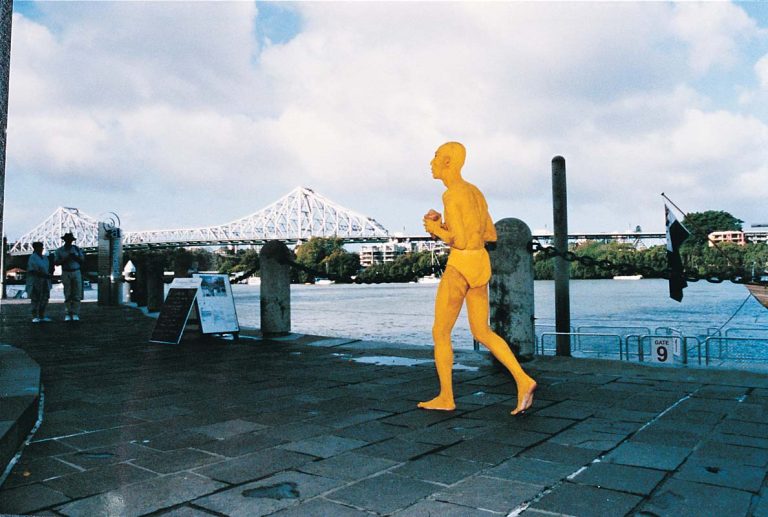We acknowledge the Traditional Owners of the land on which the Queensland Art Gallery | Gallery of Modern Art stands and recognise the creative contribution First Australians make to the art and culture of this country.

Lee Wen / Singapore b.1957 d. 2019 / Journey of a yellow man no. 13: Fragmented bodies/shifting ground 1999 / Videotape: 10:30 minutes, colour, stereo / Purchased 2000. Queensland Art Gallery | Gallery of Modern Art Foundation / Collection: Queensland Art Gallery | Gallery of Modern Art / © Estate of Lee Wen
Lee WenJourney of a yellow man no. 13: Fragmented bodies/shifting ground unknown date
On Display: Regional Touring Exhibition
While Lee Wen’s iconic imagery may seem rather obvious, what he articulates is a complex and multi-layered negotiation of self-representation. The all-over yellow paint exaggerates his own ethnicity as Chinese, but rather than suggesting a straightforward embrace of Chinese-ness, his ‘performance’ of identity is ambiguous and playful.
For the ‘Third Asia-Pacific Triennial of Contemporary Art’ in 1999, Lee Wen made a walk as the Yellow Man from a suburban home in Brisbane through the CBD to the Cultural Precinct at Southbank. Throughout his journey Lee Wen carried an ox’s heart in his hands, which he split on the steps of the Queensland Art Gallery and uttered the simple words ‘Open heart’. An unceasing interrogator of social and cultural norms, Lee Wen offered the following reflection:
Cultural production exists in dialectical relationship between society and the individual as also between the artist and the community. We all exist within a social system which is seemingly internally coherent but may not be easily translated outside . . . Each of us exists within a certain axis of cultural and historical location. Are we able to see clearly where we came from, where we are now or where it’s leading us? One finds familiarity and strangeness in every place we go. Our awareness is sharpened in new locations and experiences . . . Journeys were taken in search of something other than where we came from or as inevitabilities in order to continue our existence and growth as our identities takes us.1
Endnotes:
1 Lee Wen, Artist’s Statement, 1999.
Lee Wen turned his back on a banking career to pursue studies in art at La Salle-SIA College of the Arts and City of London Polytechnic. Alongside Amanda Heng, Koh Nguang How, Zai Kuning, Vincent Leow and others, Lee Wen became one of the earliest members of The Artist Village (TAV). Founded by the performance and installation artist Tang Da Wu in 1988, TAV functioned as an open studio promoting interdisciplinary experimental practice, highly engaged with the world around it. With the closure of the original village in 1990, TAV became an itinerant entity no less committed to creative interventions into the fabric of Singaporean social life. It was during this period that Lee Wen developed the Yellow Man, his best-known performance persona. Stripping to his trunks, Lee Wen would coat himself entirely in yellow paint, exaggerating his Chinese-Malay ethnicity, and undertaking actions in a variety of spaces, from conventional galleries to city streets.